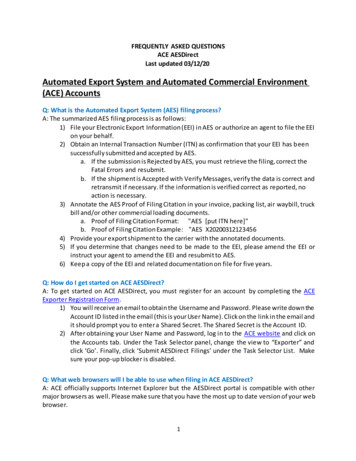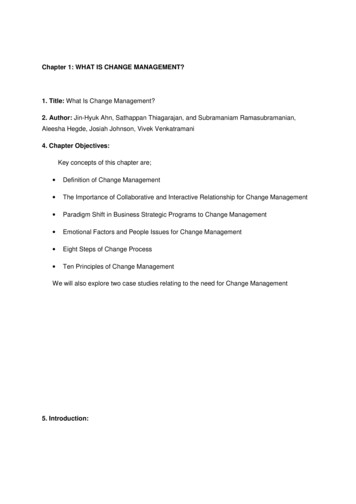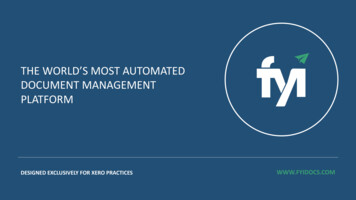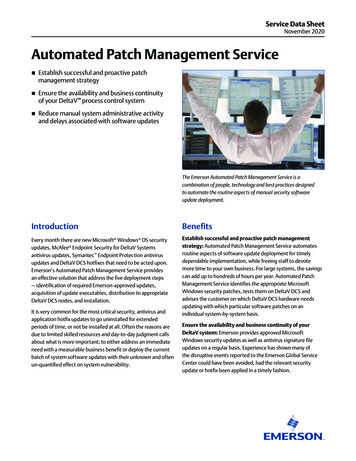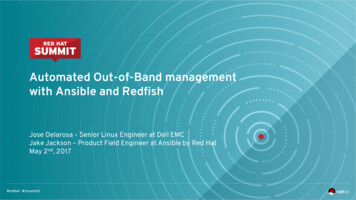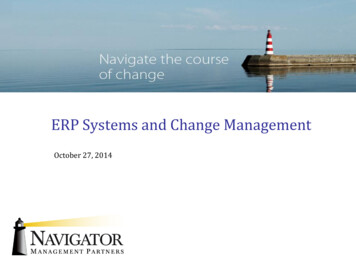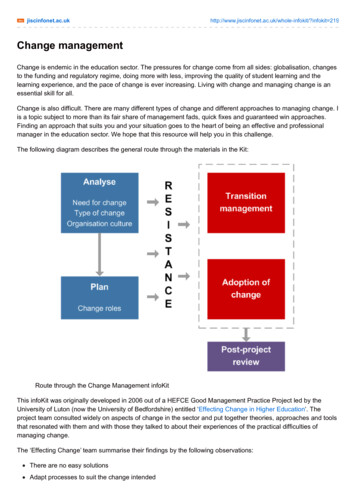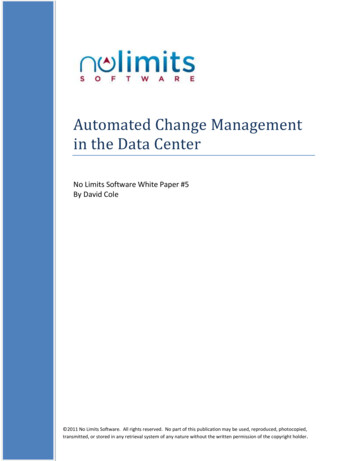
Transcription
Automated Change Managementin the Data CenterNo Limits Software White Paper #5By David Cole 2011 No Limits Software. All rights reserved. No part of this publication may be used, reproduced, photocopied,transmitted, or stored in any retrieval system of any nature without the written permission of the copyright holder.
Table of ContentsOverview. 3Why Should Change Management be Automated? . 4Requirements for Automated Change Management. 4Accurate and Detailed Asset Configuration Information. 5Logged and Detected Change Information . 7Summary. 8About No Limits Software . 9Bibliography. 9www.nolimitssoftware.comNo Limits Software2
OverviewThe onlyacceptablenumber ofunauthorizedchanges is zero.In studying a number of “high-performing” IT organizations, the authors of The VisibleOPS Handbook: Implementing ITIL in 4 Practical and Auditable Steps (Behr, Kim, &Spafford, 2004-2005) found these organizations shared a common philosophy whichstates “the only acceptable number of unauthorized changes is zero”. It is this cultureof change management which allows these organizations to perform at very highlevels as measured by:High availability (high MTBF and low MTTR)Change success rates over 99%Less than 5% time spent on unplanned workServer to system administrator ratios greater than 100:1The authors found the following:Automatedchangemonitoring canreduce MTTR andincrease systemavailability.Each of the high performing IT organizations had a common way to resolveservice outages and impairments. They all realized that 80% of their outageswere due to a change, and that 80% of their MTTR was trying to find out whatchanged. Consequently, when working on problems, they would first look atchanges in the repair cycle. Evidence of this could be seen in the troubleticketing systems of the high performers – inside the trouble tickets for anoutage were all of the scheduled and authorized changes for the affectedasset, as well as the actual detected changes on the asset. By just looking atthis information, problem managers could recommend a fix to the problemover 80% of the time, with a first fix rate of over 90% (i.e., 90% of therecommended fixes worked the first time).For many organizations, modifying this first response represents a complete departurefrom their “reboot it and see if that fixes it” philosophy. For other organizations, usingthe change log in problem diagnosis is business as usual, but these organizationsunderstand there are often cases where people have circumvented the changecontrol process and, as a result, all changes may not be approved and logged. Thiswhite paper will discuss the importance of automating the change managementprocess to detect changes made to the IT and facilities infrastructure which mighthave been made outside of the standard procedures. The result will be higheravailability, less time spent analyzing outages, and less time spent on unplanned work.www.nolimitssoftware.comNo Limits Software3
Why Should Change Management be Automated?If everyone adhered to the change management processes, we would see thefollowing:All changes would be submitted to the change advisory board (CAB).The CAB would approve the change, which would then be implementedwithin the approved change window.There would be a post-implementation review of the change to determinewhether or not the change succeeded.o If the change failed, the back out plan would be implemented.The change success rate would be updatedOrganizationsimplementingchangemonitoring areoften shockedby the numberof changesmade outside ofthe standardchangemanagementprocess.Unfortunately, adherence to these processes is not guaranteed. The use of changemonitoring software automates the detection of changes, allowing us to determine allchanges which were made, regardless of whether the changes were authorized or not.Organizations implementing change monitoring software are often shocked by thenumber of changes which are being made outside of the standard changemanagement process.In fact, even organizations with strict adherence to change management procedurescan benefit from change monitoring software. Change monitoring systems can beused to verify completion of tasks. For example, an authorized change ticket to installa new software application can be verified when the change monitoring softwarerecognizes the new application has been installed. The same would hold true for theaddition or removal of hardware, changing a network port, changing set points on aCRAC unit, upgrading the firmware in a UPS and so on. In addition, automaticallytracking the changes greatly reduces manual data entry errors, preventing the newoperating system installation from being entered as “Microsfot Windws 7”. Thechange monitoring software would retrieve the new operating system directly fromthe server and correctly enter the value of “Microsoft Windows 7”.Requirements for Automated Change ManagementThere are two primary requirements for automating the change management process:Accurate and detailed asset configuration informationLogged and detected change informationLet’s look at both of these requirements in more detail to explain their importance inthe change management process.www.nolimitssoftware.comNo Limits Software4
Accurate and Detailed Asset Configuration InformationThe first requirement for automated change management is accurate and detailedasset configuration information. Why is this important? Let’s use a common issue tohelp explain the need for this information. A user calls into the help desk and saysthey can’t access information provided through a web-based application. Let’s put onour troubleshooting hat and go to work. We could start by asking the user basicquestions such asWhat server does the application run on?We could then drill down into more detailed information such asWhat operating system does the server use?What service packs are installed?What version of the database is installed?What web server is being used?We must be ableto quickly andaccuratelydetermine theinformation weneed to troubleshoot an issue.Of course, our user may or may not know this information. Worse, the informationthey provide may be inaccurate. It is therefore important for us to be able to access asource of truth to quickly and accurately determine the information we need.Without this information, we’ve greatly added to the time required to resolve theissue and, in doing so, decreased our availability.With the asset information in hand and using our first response method of examiningchanges to determine what might have caused the issue, we take the followings steps:1. Determine the server on which the web application runsData Source – Detailed configuration information from the CMDB2. Examine the changes on the server to see if any of these changes might havecaused the issueData Source – Event logThis methodology will typically allow us to successfully diagnose problems over 50% ofthe time. While this is a great first step, it only works if the change was on the assetitself. If there was a hardware, software, or network configuration change on theserver, we might be able to successfully diagnose the problem. But what if the changeoccurred upstream from the server? What if the router into which we are pluggedhad a firmware upgrade or was moved to a different port on its upstream router?www.nolimitssoftware.comNo Limits Software5
It becomes clear that we need more information at this point. We need to know thenext level of infrastructure – the network and power devices to which the server isconnected. We might also need to know the rack in which our server resides. Wheredo we get this information? We go back to the detailed configuration data for theserver to get its location, its power and network connections and any other pertinentinformation. Again, we want to be able to retrieve this information quickly andaccurately.If we can’t find a change on the server which may have caused the issue, we nowexpand our search to changes made at the next level of infrastructure. We’ll look atchanges on the network and power devices to see if they’ve had changes which mayhave caused our issue. By expanding our search to the next level of infrastructure, wecan increase our successful diagnosis of the issue to over 70% of the time!The change logfor the asset andthe next level ofinfrastructureprovidessuccessful issuediagnosis over70% of the time!RouterChange log for asset will typicallyallow diagnosis of 50% of problemsExpanding search to next level ofinfrastructure increases successfuldiagnosis to over 70%ServerRackRackPDURemember the importance of having quick access to accurate data. But how does thedata get into the system? In most cases, the entry of data into the configurationmanagement database (CMDB) is done manually. This manual entry presents severalproblems.The first is the time and cost to collect (and to later audit) the asset data. Datacenters can contain thousands of servers, power, cooling, storage and networkdevices. Each of these devices has a relationship to other devices. It is a verydaunting task to collect data about each piece of IT equipment, particularly if you arestarting from scratch. While “visible” data (name, manufacturer, model, serialnumber, location) can be gathered reasonably quickly, retrieving the detailedconfiguration data we need (processor, storage, memory, network and powerwww.nolimitssoftware.comNo Limits Software6
connections, software, and so on) may involve logging into the server and usingvarious tools to collect the information. This information, in turn, must then bemanually entered into the CMDB.The error ratefor manuallyentered assetconfigurationinformationcan be 10%or higher.The second problem with manual data entry is the accuracy of the information. In theComputer Associates technology brief Striving to Achieve 100% Data Accuracy: TheChallenge for Next Generation Asset Management (Watson & Fulton, 2009), theauthors point out the difficulty in maintaining the accuracy of manually enteredinformation. The authors point out thatManual tracking with pen and clipboard, or even spreadsheets is timeconsuming and highly error-prone. Organizations can typically expect a 10%error rate in manual data entry due to typing and transcribing errors.In a survey of the International Association of IT Asset Managers (IAITAM) members,respondents said an 85% accuracy rate for tracking IT assets was above average andthat a 90-95% rate was exceptional. Consider for a moment the impact of a 10% errorrate in a data center with 1,000 servers. As many as 100 of the servers will haveinaccurate data recorded! Remember that this is the crucial information we need tobe able to diagnose and resolve issues in the data center. If it is inaccurate, we’veseverely reduced our capabilities to quickly resolve issues.Logged and Detected Change InformationThe second requirement for automated change management is access to both loggedand detected change information. Why is this important? If change is the cause of asmuch as 80% of outages, the ability to examine the change logs for an asset and itssupporting infrastructure is a crucial tool in resolving problems.The list of changes must be complete in order to properly diagnose issues. This meansthe change log must contain all changes which occurred – whether the changes wereauthorized or not. There are many instances where a manual change log will beincomplete or contain inaccurate information:Someone forgot to log the changeThe change has made but not yet entered into the change logSomeone circumvented the process and made a change without authorizationThe change information was incorrectly loggedInformation from a vendor isn’t entered into the system (a firmware upgradeas part of a PM, for example)Automated change monitoring will recognize and automatically log ALL detectedchanges and will resolve issues with information being forgotten or enteredincorrectly as well as detecting changes made outside of the standard changemanagement procedures.www.nolimitssoftware.comNo Limits Software7
SummaryChange is a major cause of outages in the data center. Knowing this, many datacenter managers have changed their first response to problem solving. Instead ofusing intuition to attempt to determine the correct response or taking a more drasticstep such as rebooting a server, the first step is to examine the change log for theasset and its supporting infrastructure. This typically allows successful diagnosis ofthe problem over 70% of the time.In order to modify this first response, there are two key requirements:Accurate and detailed asset configuration informationManually entered data is prone to errors of 15% or more. Automatedgathering of device configuration will greatly improve the accuracy of theinformation.Logged and detected change informationIt is important to have a complete record of all changes made – whetherauthorized or not. It is recommended that the systems are scanned forchanges at least once a day. The ability to track both authorized changes anddetected changes – changes made but not neces
In studying a number of “high-performing” IT organizations, the authors of The Visible OPS Handbook: Implementing ITIL in 4 Practical and Auditable Steps (Behr, Kim, & Spafford, 2004-2005) found these organizations shared a common philosophy which states “the only acceptable number of unauthorized changes is zero”. It is this culture of change management which allows these .

